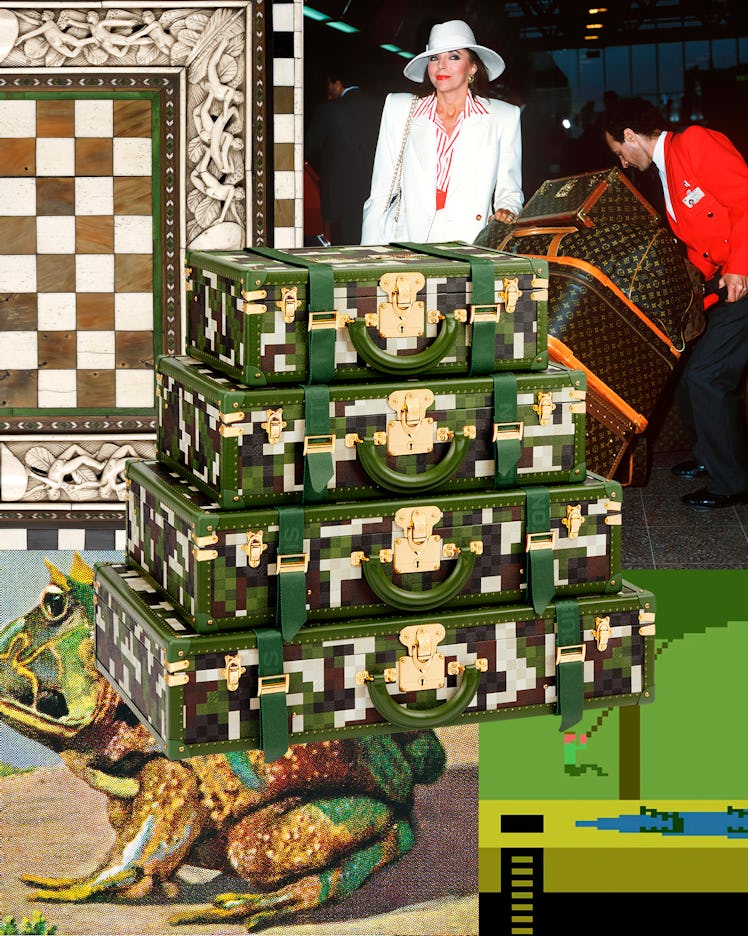The Story Behind Pharrell Williams’s Damoflage For Louis Vuitton Men’s
The musician-designer gives camo new ammo at the luxury house.

Fittingly for a hip-hop multi-hyphenate known for his creative sampling, Pharrell Williams remixed the Louis Vuitton codes with abandon in his first outing as men’s creative director of the brand. Chief among these riffs was his artful tweaking of the Damier, the brown and black checkerboard design that has become a ubiquitous Louis Vuitton signifier and a staple of chic wardrobes and airport luggage carousels everywhere.
Williams, who launched his clothing lines Billionaire Boys Club and IceCream with A Bathing Ape’s Nigo in the aughts, is a master at manipulating visual cues to influence the culture. The genre bender used the checkerboard motif as a canvas to express his new vision for the house, working alongside digital creator ET Artist to treat the squares like eight-bit Atari graphics. He reimagined them in new colorways and as pixelated versions of digital camouflage—or Damoflage, as Williams dubbed it—that appeared on everything from striking outerwear to classic Louis Vuitton trunks. “I used the grid as a platform to play with different artistic techniques,” says Williams. “I wanted to make a print that makes people say, ‘Okay, that’s P., and that’s Damier.’ ”
Dennis Stone/Shutterstock
Pascal Chevaller/Gamma-Rapho via Getty Images
Courtesy of Louis Vuitton
Conceived in 1888 by Georges Vuitton, the son of founder Louis Vuitton, the Damier predates the iconic LV monogram—and even camouflage itself, which harks back to World War I, when it was introduced to conceal military personnel and machinery. Soon after, the pattern was referenced by artists such as Georges Braque, and made it into Vogue as early as 1943, in a four-page story extolling its virtues written by an army major who described it as “makeup on a large scale.” In the ’60s and ’70s, it was co-opted by countercultural rebels who thrifted at army-navy stores and turned vintage fatigues into streetwear, subverting their military connotations. Camo was back in the high fashion arena in 1987, when the late designer Stephen Sprouse reworked Andy Warhol’s “Camouflage” screen prints to use on his club-couture clothes and accessories. Sprouse later reprised the motif in his 2001 graffiti collaboration with Louis Vuitton’s then creative director, Marc Jacobs.
In nature, all sorts of animals—including spiders, stick insects, frogs, owls, and marine organisms—shrewdly change their color, texture, and shape to blend in with their surroundings and avoid the unwanted attention of predators. In fashion, however, the effect of camouflage is precisely the opposite. Thanks in no small part to Williams, who wears enough camo to rival a drill sergeant, it is fast becoming the uniform of celebrities, influencers, and attention-seeking bad boys and girls. In its latest and most stylish incarnation, camouflage has gone from a stealthy form of disguise to the last word in look-at-me fashion.
Julien De Rosa/AFP via Getty Images
Ashmolean Museum/Heritage Images/Getty Images
© Activision, Courtesy of Atari
Nextrecord Archives/Getty Images
This article was originally published on